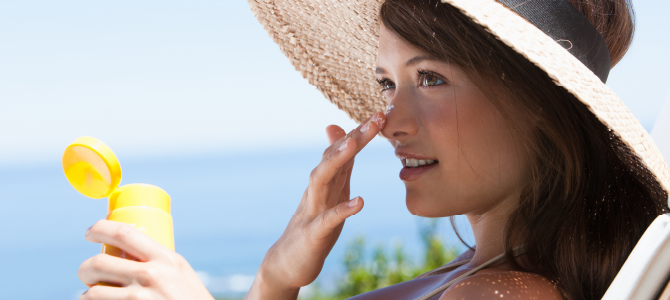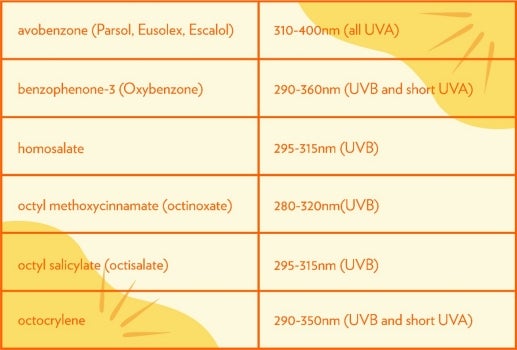Understand the Ins and Outs of Your Sunscreen
August 01, 2021

Many dermatologists agree that one of the most important things you can do for your skin is wear sunscreen. While essential for life, the sun releases different kinds of ultraviolet radiation, the most common being UVA and UVB. UVA rays have a wavelength between 320-400 nm and are known to contribute to photoaging and hyperpigmentation and may even contribute to skin cancer. UVB rays have a wavelength between 280-320 nm, and exposure to these sunrays can cause sunburns, skin cancer, hyperpigmentation, and skin inflammation. Often not fully understood, sunscreens are one of the easiest ways to protect your skin from UV damage. Here are some common questions and answers about sunscreen.
What are sunscreens?
Sunscreens are topical formulations that contain specific ingredients that either absorb or scatter ultraviolet radiation to protect the skin from damage. Sunscreen agents—the ingredients themselves— can take one of two forms: physical (often referred to as “inorganic”) or chemical (considered “organic”). The main difference between these two forms is how they protect skin.
Physical Sunscreens
Physical sunscreen agents are inorganic, which, in chemistry terms, means they don’t contain carbon. The two most common physical sunscreen agents are titanium dioxide and zinc oxide. These two are minerals or metal oxides that reflect and scatter UV radiation. Titanium dioxide works against light up to 400 nm (UVA and UVB), while zinc oxide is effective up to 370 nm (some UVA and all UVB). Not only are these two functionally great as they are, but they also have the panache of being natural, too. On the downside, though, many people don’t like how they go on white when applied to the skin.
Chemical Sunscreens
Organic (meaning carbon containing) sunscreen agents are chemical based. They work by absorbing UV radiation instead of scattering or reflecting it. There are several different organic sunscreen options available with varying protections against different UV wavelengths. These sunscreen agents are usually mixed to garner full or broad-spectrum coverage. Here are some of the commonly used chemical sunscreens and the range of wavelengths against which they provide protection:

What is “Sun Protection Factor” or SPF?
Technically speaking, the Sun Protection Factor, known as SPF, is the amount of protection a product offers against UVB irradiation. You can calculate the amount of protection a SPF will give you by taking the SPF number and multiplying it by the amount of time you typically take to burn. For example, if you typically burn after 20 minutes of sun exposure, an SPF of 15 will provide 300 minutes, or 5 hours, of protection (i.e., 20 minutes x 15 SPF = 300 minutes of protection). Of course, sunscreens tend to wear off, so you’d need to reapply per the directions for use. The term “broad-spectrum” indicates that similar protection is provided for UVA, as is indicated for UVB, from the SPF rating.
What is the PA rating?
Some countries use PA ratings for their sunscreens. This rating system was adapted from the Persistent Pigmentation Darkening (PPD) method used to evaluate UVA radiation and the time it takes to tan—resulting in persistent darkening—of the skin. The differences between protected and unprotected skin are compared. If the results indicate it takes two to four times more UVA exposure, then the rating is a PA+, four to eight times the UVA equals PA ++, eight to 16 times provides a PA+++. Yet, if the skin can handle 16 times or more UVA exposure, the results are the highest, PA++++.
So basically, the ratings mean the following:

Can sunscreen block out all UV radiation?
No, sunscreen cannot block all UV rays. For example, an SPF 15 or higher can filter out 93% of the UVB rays. SPF 30 (or higher) can filter 97%. Yet SPF 50 (or higher) can filter 98% of the UVB rays. So, the higher the better, but it starts to have a diminishing return. The general recommendation is to wear an SPF of 15 + every day—even if indoors. If you are spending the day outside, a water-resistant SPF of 30 plus is your best solution.
What is the best sunscreen to use?
Besides ensuring that the product offers broad-spectrum protection (both and equal UVA and UVB), the American Academy of Dermatology (AAD) recommends wearing the sunscreen you like best and are willing to wear. The key is to consistently wear sunscreen, so make sure it is a formula you like and are comfortable wearing regularly.
What’s the best way to apply sunscreen?

You should apply sunscreen 15-20 minutes before sun exposure. This allows the ingredients to absorb into your skin and provide their full efficacy. The amount of sunscreen is likely more than you are typically applying. One ounce of sunscreen product is recommended for full body use. An easy way to ensure you are properly applying your sunscreen is to use the two-finger rule. Dispense a line of sunscreen down the entirety of your index and middle finger.
Apply this amount to each of the following areas:

- Head, neck, and face
- Left arm
- Right arm
- Upper back
- Lower back
- Upper front torso
- Lower front torso
- Left upper leg and thigh
- Right upper leg and thigh
- Left lower leg and foot
- Right lower leg and foot
How often should I apply sunscreen?
While sunscreens can provide extended sun protection based on their SPF rating, this doesn’t mean they don’t need to be reapplied. Be sure to read the directions for use and reapply as indicated. Sunscreens can be water-resistant but not waterproof. They will wear off from swimming, sweating, towel drying, or simply being rubbed off. Whether you are using SPF 30 or SPF 50, you will likely need to reapply around the same amount of time.
Do sunscreens harm the environment—like coral reefs?
There is very little scientific evidence to suggest that sunscreen chemicals cause coral damage. For example, the National Oceanic and Atmospheric Administration has named temperature/climate change, runoff, pollution, overexposure to sunlight, and low tides as the culprits of coral bleaching. Additional research is being conducted and we will continue to monitor the situation carefully and make changes if needed. However, Sunright® 35 has been formulated with physical sunscreen agents, which comply with current local legislation requirements related to this issue.
The bottom line is to make sunscreen a priority in your daily skin care routine. There are many options for those who wear makeup or have sensitive skin. We will all benefit from properly using sunscreen and our skin will thank us now and in the future.
-
Summer is in full swing! Outdoor activities from hiking to pool-side lounging are beckoning, but a year-long pandemic might have you looking for a jump start on your healthy summer glow by using a sunless tanner. Healthy, of course, is the key here as there are many mixed claims about sunless tanners, their ingredients, and the protection they provide. Here is a quick look at the science behind a ...
-
Children’s bodies are constantly growing, and their brains are always taking in more information. They are working hard to decipher and understand what they are learning. In fact, during the first 5-8 years of life, children brains develop and learn faster than at any other time. A good foundation is essential for helping them succeed in school and life. At this stage, children are learning how to...

